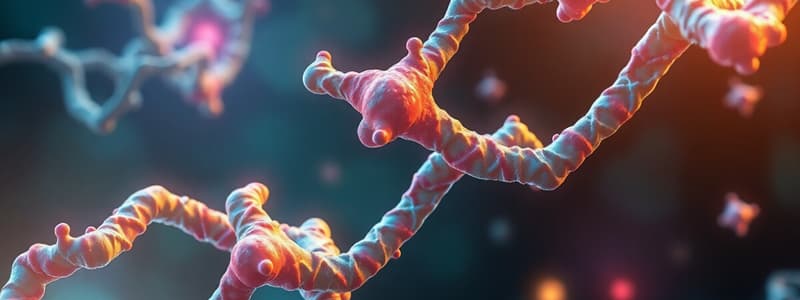Podcast
Questions and Answers
Which statement about enzymes is true?
Which statement about enzymes is true?
- Enzymes are primarily carbohydrates.
- All enzymes have a rigid structure.
- Most enzymes are proteins. (correct)
- Enzymes do not require cofactors.
What distinguishes digestive enzymes from other enzymes?
What distinguishes digestive enzymes from other enzymes?
- They are less active at higher pH levels.
- They only catalyze reactions involving carbohydrates.
- They do not require specific temperatures.
- They have names that end with -in. (correct)
At what temperature do most enzymes exhibit optimum activity?
At what temperature do most enzymes exhibit optimum activity?
- 37°C (correct)
- 25°C
- 100°C
- 10°C
What happens to enzyme activity at extremely high temperatures?
What happens to enzyme activity at extremely high temperatures?
What is the effect of pH on enzyme activity?
What is the effect of pH on enzyme activity?
Which model describes the enzyme's flexibility in binding to the substrate?
Which model describes the enzyme's flexibility in binding to the substrate?
What occurs when substrate concentration is increased?
What occurs when substrate concentration is increased?
Which statement about the active site of an enzyme is correct?
Which statement about the active site of an enzyme is correct?
What happens to the enzyme's shape when a substrate binds according to the induced fit model?
What happens to the enzyme's shape when a substrate binds according to the induced fit model?
Which class of enzymes is responsible for transferring a group of atoms from one molecule to another?
Which class of enzymes is responsible for transferring a group of atoms from one molecule to another?
In competitive inhibition, what is the primary action of the inhibitor?
In competitive inhibition, what is the primary action of the inhibitor?
Which of the following statements is true regarding noncompetitive inhibition?
Which of the following statements is true regarding noncompetitive inhibition?
What type of reaction do lyases typically catalyze?
What type of reaction do lyases typically catalyze?
Which of these conditions would likely decrease the rate of an enzymatic reaction?
Which of these conditions would likely decrease the rate of an enzymatic reaction?
What is a characteristic feature of oxidoreductases?
What is a characteristic feature of oxidoreductases?
Which enzyme classification does not involve the breaking or forming of bonds?
Which enzyme classification does not involve the breaking or forming of bonds?
Flashcards
Induced Fit Model
Induced Fit Model
Enzyme changes shape when substrate binds, increasing the rate of reaction.
Competitive Inhibition
Competitive Inhibition
Inhibitor similar to substrate, competes for active site, effects reversed by increasing substrate.
Noncompetitive Inhibition
Noncompetitive Inhibition
Inhibitor binds to enzyme, NOT active site, changing shape, substrate cannot fit.
Enzyme Active Site
Enzyme Active Site
Signup and view all the flashcards
Oxidoreductase
Oxidoreductase
Signup and view all the flashcards
Transferase
Transferase
Signup and view all the flashcards
Hydrolase
Hydrolase
Signup and view all the flashcards
Enzyme Classification (Main idea)
Enzyme Classification (Main idea)
Signup and view all the flashcards
Enzyme Function
Enzyme Function
Signup and view all the flashcards
Enzyme Cofactors
Enzyme Cofactors
Signup and view all the flashcards
Enzyme Naming Convention
Enzyme Naming Convention
Signup and view all the flashcards
Enzyme Action: Lock & Key
Enzyme Action: Lock & Key
Signup and view all the flashcards
Enzyme Action: Induced Fit
Enzyme Action: Induced Fit
Signup and view all the flashcards
Enzyme Temperature Effect
Enzyme Temperature Effect
Signup and view all the flashcards
Enzyme pH Effect
Enzyme pH Effect
Signup and view all the flashcards
Substrate Concentration Effect
Substrate Concentration Effect
Signup and view all the flashcards
Study Notes
Enzymes
- Most enzymes are proteins.
- Enzymes contain cofactors: metal ions and vitamins.
- Enzyme names typically end with "-ase" (e.g., sucrase, lipase).
- Examples of digestive enzymes include pepsin, trypsin, and chymotrypsin.
Enzyme Action
- Lock and Key Model: A substrate fits into a specific active site on the enzyme, like a lock and key. Only specific substrates fit. The enzyme-substrate complex forms, and products are released.
- Induced Fit Model: The enzyme's active site is flexible. It changes shape to accommodate the substrate, further enhancing the binding.
- Factors Affecting Enzyme Activity:
- Temperature: Enzymes have optimal temperatures for activity (typically 37°C). Activity decreases at both higher and lower temperatures due to denaturation or insufficient kinetic energy.
- pH: Enzymes have optimal pH values. Activity decreases significantly above or below these values.
- Substrate Concentration: Increasing substrate concentration increases the reaction rate up to a point where all available enzymes are saturated.
Enzyme Inhibition
- Competitive Inhibition: Inhibitors have a similar shape to the substrate, competing for the active site. Increasing substrate concentration can overcome this inhibition.
- Noncompetitive Inhibition: Inhibitors bind to a different site (allosteric site) on the enzyme, changing its shape and reducing its activity. Increasing substrate concentration does not overcome this inhibition.
Studying That Suits You
Use AI to generate personalized quizzes and flashcards to suit your learning preferences.




